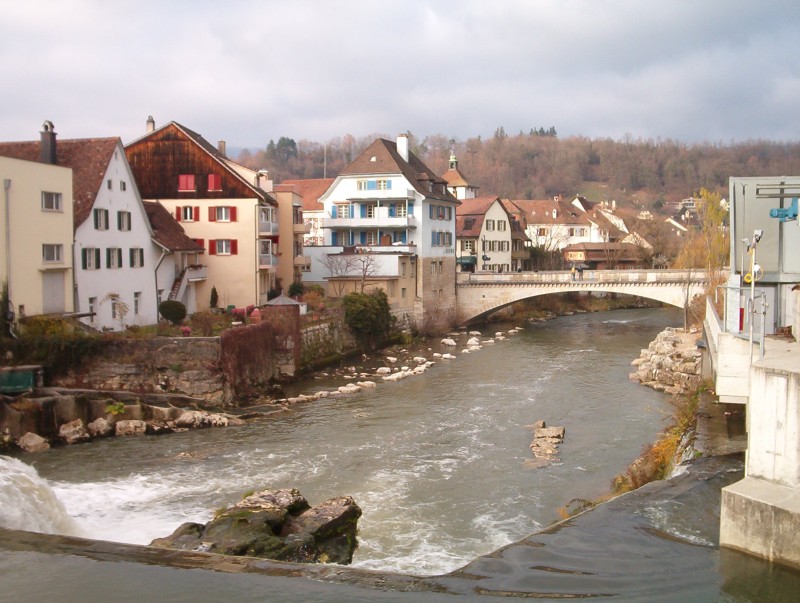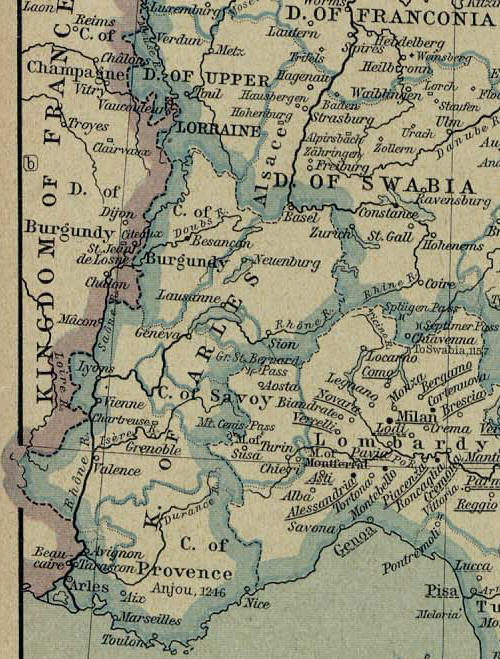|
Laufen, Basel-Country
Laufen (; French language, French: ''Laufon'' ; High Alemannic German, High Alemannic: ''Laufe'') is a Municipalities of Switzerland, municipality and the capital of the district of Laufen (district), Laufen in the Cantons of Switzerland, canton of Basel-Country in Switzerland. Laufen railway station, Laufen is a principal train station for the surrounding area, connecting it to Basel. History Between 58 BC and 470 AD, Laufen was part of the Roman Empire; after the empire collapsed it was part of the Alemanish area for several decades. During the early sixth century, the entire valley came into the possession of France, and from 853 until 1033 it was part of Kingdom of Burgundy, the Burgundian Kingdom. In 999 Rudolf III of Burgundy, Rudolf III, the childless king of Burgundy donated most of the Laufen valley territory to the Roman Catholic Diocese of Basel, Archbishopric of Basel. Laufen is first mentioned in 1141 as ''Loufen''. For a time, it was known by its French language, ... [...More Info...] [...Related Items...] OR: [Wikipedia] [Google] [Baidu] |
Basel
Basel ( ; ), also known as Basle ( ), ; ; ; . is a city in northwestern Switzerland on the river Rhine (at the transition from the High Rhine, High to the Upper Rhine). Basel is Switzerland's List of cities in Switzerland, third-most-populous city (after Zurich and Geneva), with 177,595 inhabitants within the city municipality limits. The official language of Basel is Swiss Standard German and the main spoken language is the local Basel German dialect. Basel is commonly considered to be the cultural capital of Switzerland and the city is famous for its many Museums in Basel, museums, including the Kunstmuseum Basel, Kunstmuseum, which is the first collection of art accessible to the public in the world (1661) and the largest museum of Swiss art, art in Switzerland, the Fondation Beyeler (located in Riehen), the Museum Tinguely and the Museum of Contemporary Art (Basel), Museum of Contemporary Art, which is the first public museum of contemporary art in Europe. Forty museums ... [...More Info...] [...Related Items...] OR: [Wikipedia] [Google] [Baidu] |
German Language
German (, ) is a West Germanic language in the Indo-European language family, mainly spoken in Western Europe, Western and Central Europe. It is the majority and Official language, official (or co-official) language in Germany, Austria, Switzerland, and Liechtenstein. It is also an official language of Luxembourg, German-speaking Community of Belgium, Belgium and the Italian autonomous province of South Tyrol, as well as a recognized national language in Namibia. There are also notable German-speaking communities in other parts of Europe, including: Poland (Upper Silesia), the Czech Republic (North Bohemia), Denmark (South Jutland County, North Schleswig), Slovakia (Krahule), Germans of Romania, Romania, Hungary (Sopron), and France (European Collectivity of Alsace, Alsace). Overseas, sizeable communities of German-speakers are found in the Americas. German is one of the global language system, major languages of the world, with nearly 80 million native speakers and over 130 mi ... [...More Info...] [...Related Items...] OR: [Wikipedia] [Google] [Baidu] |
Coat Of Arms
A coat of arms is a heraldry, heraldic communication design, visual design on an escutcheon (heraldry), escutcheon (i.e., shield), surcoat, or tabard (the last two being outer garments), originating in Europe. The coat of arms on an escutcheon forms the central element of the full achievement (heraldry), heraldic achievement, which in its whole consists of a shield, supporters, a crest (heraldry), crest, and a motto. A coat of arms is traditionally unique to the armiger (e.g. an individual person, family, state, organization, school or corporation). The term "coat of arms" itself, describing in modern times just the heraldic design, originates from the description of the entire medieval chainmail "surcoat" garment used in combat or preparation for the latter. Roll of arms, Rolls of arms are collections of many coats of arms, and since the early Modern Age centuries, they have been a source of information for public showing and tracing the membership of a nobility, noble family, a ... [...More Info...] [...Related Items...] OR: [Wikipedia] [Google] [Baidu] |
Blazon
In heraldry and heraldic vexillology, a blazon is a formal description of a coat of arms, flag or similar emblem, from which the reader can reconstruct an accurate image. The verb ''to blazon'' means to create such a description. The visual depiction of a coat of arms or flag has traditionally had considerable latitude in design, but a verbal blazon specifies the essentially distinctive elements. A coat of arms or flag is therefore primarily defined not by a picture but rather by the wording of its blazon (though in modern usage flags are often additionally and more precisely defined using geometrical specifications). ''Blazon'' is also the specialized language in which a blazon is written, and, as a verb, the act of writing such a description. ''Blazonry'' is the art, craft or practice of creating a blazon. The language employed in ''blazonry'' has its own vocabulary and syntax, which becomes essential for comprehension when blazoning a complex coat of arms. Other armorial ob ... [...More Info...] [...Related Items...] OR: [Wikipedia] [Google] [Baidu] |
Birs
The Birs (French: ''Birse'') is a long river in Switzerland that flows through the Jura region and ends as a tributary to the Rhine between Basel and Birsfelden. It is the most important river of the Swiss Jura. Course The Birs has its source in a spring near the '' Col de Pierre Pertuis'' at above sea level a little southwest of Tavannes in the ''Jura bernois''. It starts as a proper river; the large amount of water is the product of an extended underground river system. The Birs runs through wider valleys (Vallée de Tavannes) and narrow gorges. Near Delémont, the capital of the canton of Jura, it joins the Sorne and the Scheulte. Between Soyhières and Liesberg, it leaves the French-speaking part of Switzerland, enters the canton of Basel-Landschaft and receives the Lützel from the left. In Laufen it forms a waterfall, which was the source of power and of the name of the city. At the gorge of Angenstein, the river runs into the ''Birseck'', the lowland by ... [...More Info...] [...Related Items...] OR: [Wikipedia] [Google] [Baidu] |
Birs Laufen
The Birs (French: ''Birse'') is a long river in Switzerland that flows through the Jura region and ends as a tributary to the Rhine between Basel and Birsfelden. It is the most important river of the Swiss Jura. Course The Birs has its source in a spring near the '' Col de Pierre Pertuis'' at above sea level a little southwest of Tavannes in the ''Jura bernois''. It starts as a proper river; the large amount of water is the product of an extended underground river system. The Birs runs through wider valleys (Vallée de Tavannes) and narrow gorges. Near Delémont, the capital of the canton of Jura, it joins the Sorne and the Scheulte. Between Soyhières and Liesberg, it leaves the French-speaking part of Switzerland, enters the canton of Basel-Landschaft and receives the Lützel from the left. In Laufen it forms a waterfall, which was the source of power and of the name of the city. At the gorge of Angenstein, the river runs into the ''Birseck'', the lowland by Aesch. ... [...More Info...] [...Related Items...] OR: [Wikipedia] [Google] [Baidu] |
Roman Catholic Diocese Of Basel
The Diocese of Basel (; ) is a Latin Catholic diocese in Switzerland. Historically, the bishops of Basel were also secular rulers of the Prince-Bishopric of Basel (). Today the diocese of Basel includes the Swiss cantons of Aargau, Basel-Landschaft, Basel-Stadt, Bern, Jura, Lucerne, Schaffhausen, Solothurn, Thurgau, and Zug. Ordinaries The bishops of Basel have not resided in the city of Basel since 1528. Solothurn is the seat of the Bishop. * Jakob Christoph Blarer von Wartensee (1576–1608) * Wilhelm Rinck von Balderstein (1609–1628) * Johann Heinrich von Ostein (1629–1646) * Beat Albrecht von Ramstein (1646–1651) * Johann Franz Reichsritter von Schönau (1651–1656) * Johann Konrad von Roggenbach (1657–1693) * Wilhelm Jakob Rink von Baldenstein (1693–1705) * Johann Konrad Reichsfreiherr von Reinach-Hirzbach (1705–1737) * Jakob Sigismund von Reinach-Steinbrunn (1737–1743) * Josef Wilhelm Rinck von Baldenstein (1744–1762) * Simon Nikolaus Euseb Reichs ... [...More Info...] [...Related Items...] OR: [Wikipedia] [Google] [Baidu] |
Rudolf III Of Burgundy
Rudolph III (, ; 970 – 6 September 1032), called the Idle or the Pious, was the king of Burgundy from 993 until his death. He was the last ruler of an independent Kingdom of Burgundy, and the last legitimate male member of the Burgundian line of the Elder House of Welf. Family Rudolph was the son and heir of King Conrad I of Burgundy (925–993). His mother, Matilda (943–980), a member of the Frankish Carolingian dynasty, was the daughter of King Louis IV of France. Rudolph himself had four sisters: an elder full sister, Gisela, who married the Ottonian duke Henry II of Bavaria some time before 972, and became the mother of Emperor Henry II, and three half-sisters: Bertha, who married, firstly, Count Odo I of Blois in 983, and, secondly, King Robert II of France in 996; Matilda, who possibly married Count Robert of Geneva; and Gerberga, who married Duke Herman II of Swabia in about 988. He also had a half-brother, Burchard, archbishop of Lyons. Reign Rudolph succe ... [...More Info...] [...Related Items...] OR: [Wikipedia] [Google] [Baidu] |



